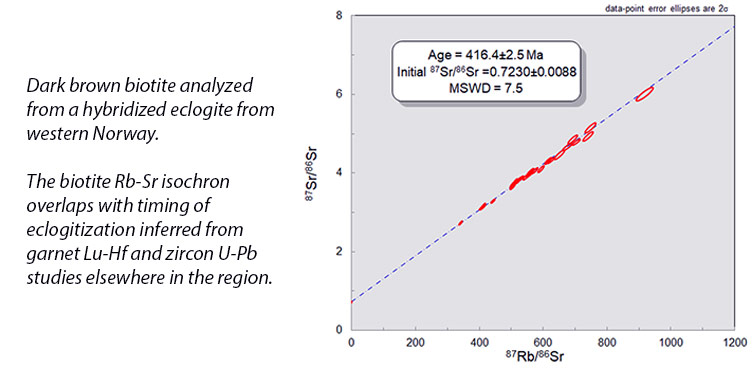Beta decay chronometry
Standards we use:
- Rb-Sr (and K-Ca) in Biotite and muscovite: primary standards used are CRPG Mica-Mg(NP), NIST610/612. Secondary standards are currently under development, including: Assynt phlogophite, Kragero annite, Amelia zinnwaldite.
- Lu-Hf in garnet, apatite and xenotime: primary standards are NIST610/612. Secondary standards for garnet are currently being developed, including: Melanite garnet from Crowsnest volcanics AB (Hf-isotope standard); almandine garnet from Archean pegmatite from Wyoming Province.
General principles
For Rb-Sr and K-Ca in micas we employ a 10% SF6 reaction gas in the 8900 octopole reaction cell. 86, 87, 88Sr isotopes are mass-shifted to 105SrF, 106SrF, and 107SrF. No reaction of 85Rb at product ion 104RbF is observed. For 87Rb/86Sr, 85Rb is analyzed on mass and the canonical 85Rb/87Rb is used to calculate the 87Rb ion beam. We have found best sensitivity of Sr reaction products is achieved at 22-25% SF6 flow and with addition of 1-2% H2 flow.
We have also tested simultaneous Rb-Sr and K-Ca. Isobaric interference of 40Ar can be eliminated (by charge transfer) using a small amount of H2 and reaction of Ca with SF6 can effectively mass shift 40Ca away from 40K. Crater sizes between 65-120µm are used depending on grain size. For micas we use relatively low laser fluence (1.5 J/cm2) and high repetition rate (7 Hz) to excavate 20-30 µm deep craters. Thick polished thin section work best of this application.
Isotope ratios are calculated offline using a custom data reduction scheme in Iolite4.0. The nano-pressed pellet of MicMg (µ-standards, Kiel) is used as primary standard. A variety of in-house mica standards of known age are used to apply an empirical mass-bias correction to the data.
Example data:

For Lu-Hf in garnet we employ a 10% NH3 reaction gas in the 8900 octopole reaction cell. 176,177,178Hf isotopes are mass-shifted by +82 as a result of reaction of Hf with cluster ions of (NH)(NH2)(NH3)3. No reaction of 175Lu product ion at mass 257 is observed. For 176Lu/177Hf, 175Lu is analyzed on mass and the canonical 175Lu/176Lu is used to calculate the 176Lu ion beam.
We have found best sensitivity of Hf reaction products is achieved at 10-12% NH3 flow. We use higher laser fluence (3-5 J/cm2) and lower repetition rate (5-7 Hz) to excavate 20-30 µm deep craters using 90-120µm spots. Thick polished thin section work best of this application.
Example data:

